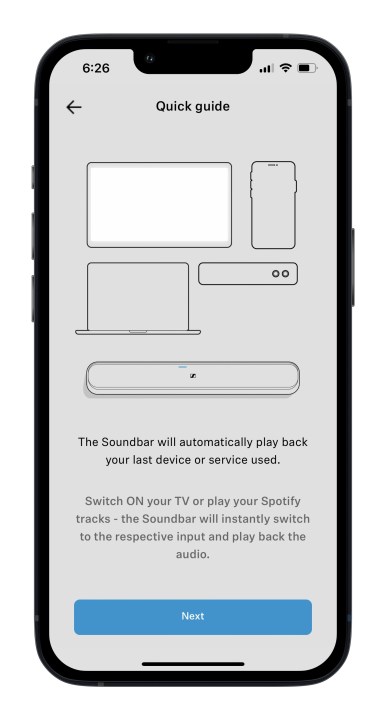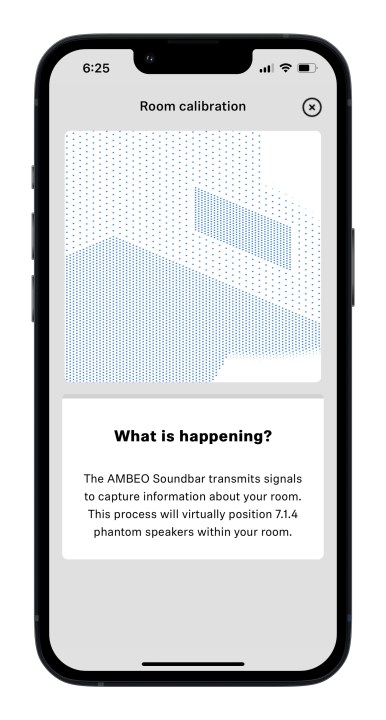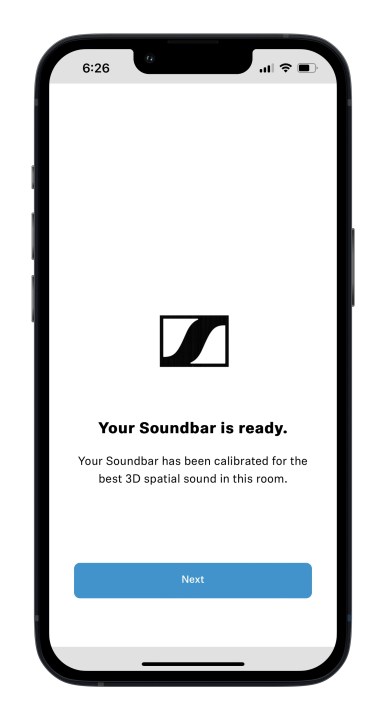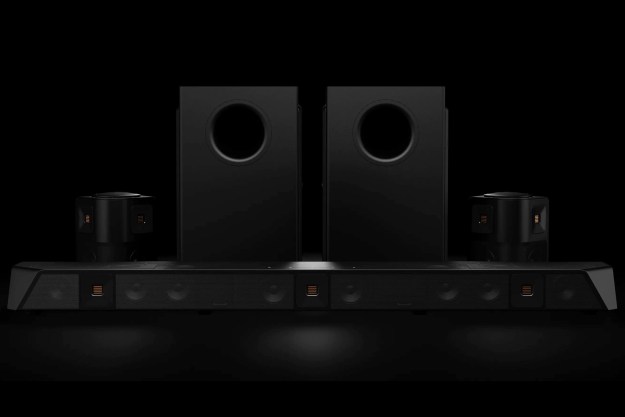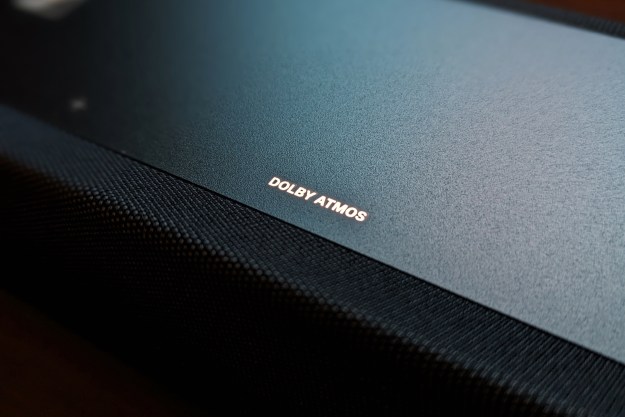
“The Ambeo Mini's impressive virtual Atmos performance can fill a small room.”
- Crystal-clear, hi-fi sound
- Easy setup
- Excellent app-based control
- Convincing virtual Dolby Atmos
- Tons of wireless streaming support
- Well-built remote included
- Expensive compared to competitors
- Bass response is too mild
- No option for wireless surround speakers
- No HDMI or optical inputs
It’s hard not to have lofty expectations of the Sennheiser Ambeo Soundbar Mini. Sennheiser’s first two Ambeo soundbars, the $2,500 Ambeo Soundbar Max and the $1,500 Ambeo Soundbar Plus, are both stunning achievements in sound, each redefining the kind of immersive Dolby Atmos soundbar experience you can expect from single-speaker systems. But both of those soundbars are designed to fill medium-to-large spaces — the Ambeo Soundbar Max is a big brute at nearly 50 inches wide, 6.7 inches tall, and weighing in at over 40 pounds.
So when Sennheiser released the much smaller and lighter Ambeo Soundbar Mini at $800 — far more expensive than its two main rivals, the Bose Smart Soundbar 600 and Sonos Beam Gen 2, I expected to be seriously impressed by its sound and features. That mostly happened, but it wasn’t a slam dunk. Here’s what you need to know.
Sennheiser Ambeo Soundbar Mini: design
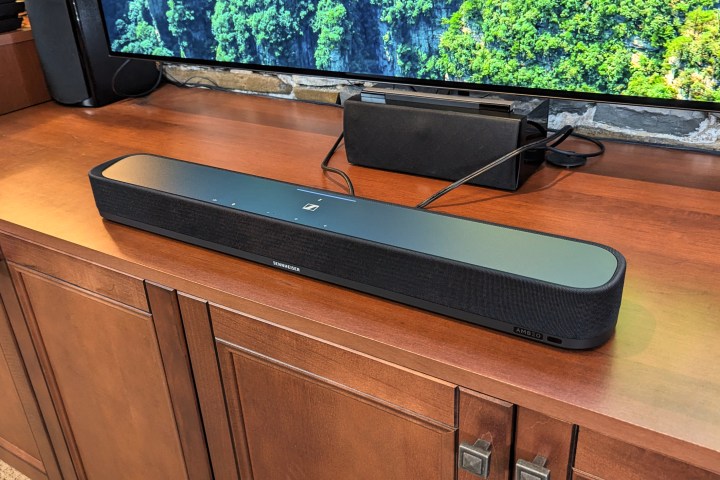
The Sennheiser Ambeo Soundbar Mini looks like a scaled-down version of the Sennheiser Ambeo Soundbar Plus, right down to the glowing Ambeo logo on the bottom right corner. That’s a good thing; it’s an elegant design that matches minimalism with the softness of a full fabric grille with a compact speaker that can sit unobtrusively in front of even a 32-inch TV. For reference, the Mini has similar dimensions to the Bose Smart Soundbar 600 and Sonos Beam Gen 2. You could, in theory, stick it directly under your TV if you have 27.5 inches of width and 2.75 inches of height with which to work. Because the Ambeo Mini only uses forward- and side-firing drivers, this probably won’t affect the sound, but it might cause problems with the speaker’s ability to calibrate itself — more on that in a moment.
Like the Soundbar Plus, there are some basic touch controls on the top surface (volume up/down, microphone mute, Bluetooth on/off, and multifunction control) plus a wide LED light bar that’s used for a variety of visual feedback like volume level, muting, and software update progress.
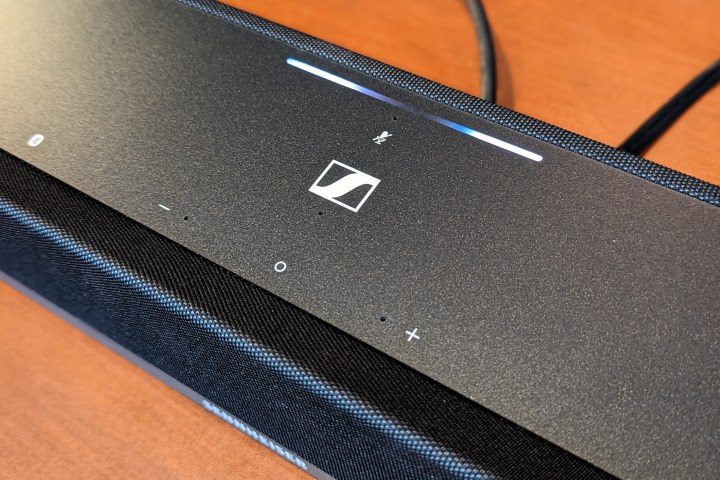
Unfortunately, depending on the height of the speaker and the height of your seating position, the raised front edge of the grille could completely obscure your view of the light bar. I had the same criticism of the Ambeo Soundbar Plus: the LED bar should have been placed where the Sennheiser logo sits, right below the grille.
It’s the same story for the soundbar’s codec indicators: the top surface has handy icons that light up when you’re listening to formats like Dolby Atmos, DTS:X, or MPEG-H, but unless you’re standing over the speaker, you’ll never see them. The only other way to get feedback on the codec in use is via the Sennheiser Smart Contol app.

Around the back of the Ambeo Mini, you’ll find just two ports: an HDMI ARC/eARC input and a USB port that Sennheiser says is meant for powering accessories. But it also works as a secondary way of installing new firmware if you don’t connect the speaker to Wi-Fi. That’s it. For a compact soundbar, this isn’t unusual — similar Bose, Sony, and Sonos models are equally bereft of connection options — but it’s a bit jarring when you compare the Mini to the Plus, which has one of the most comprehensive sets of ports we’ve ever seen on a soundbar.
In the box, you’ll find the power cord, an HDMI cable, a quick-start guide, and an Ambeo remote — the same unit that Sennheiser provides with Ambeo Plus.
Sennheiser Ambeo Soundbar Mini: the setup
Setting up the Ambeo Soundbar Mini is a breeze. The free Sennheiser Sound Control app (iOS/Android) walks you through the steps, which include connecting the speaker to your TV and to a wall plug and getting connected to your Wi-Fi network. It also triggers the Ambeo Mini’s automatic calibration feature, which uses the speaker’s built-in mics. Since they’re located on top of the soundbar, you want to make sure they aren’t blocked by your TV or cabinetry.
Technically speaking, the app-based setup is optional. You could simply connect the cables and perform the calibration via the touch controls, but it’s well worth using the app to gain access to deeper features like EQ adjustments and configuring the Ambeo Mini with Apple AirPlay 2 and/or Chromecast, both of which offer much better sound quality than the speaker’s built-in Bluetooth.
The app also is chock-full of deeper settings. You’ll find adjustments for everything from subwoofer level to LED brightness settings. It’s worth every minute spent familiarizing yourself with its various screens.
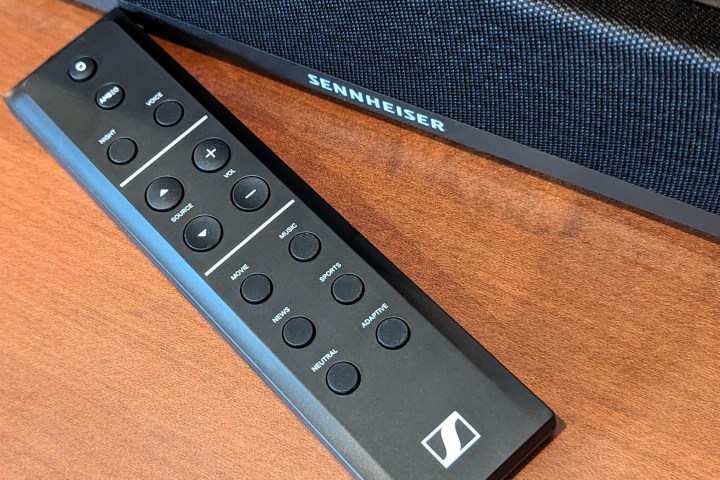
At this point, you’re good to go. Or you can continue by enabling the soundbar’s built-in Amazon Alexa smart speaker feature. If you don’t already have an Alexa smart speaker in your room, adding it might be worthwhile; the Ambeo Mini makes for a very capable Alexa host, but there is a small caveat to be aware of.
Without Alexa, the remote’s “0” multifunction button — which could easily be mistaken for a power button — acts as a mute button when listening to TV content and as a play/pause button when listening to streaming music, both very handy to have at your fingertips. Enabling Alexa changes the way that button works. Once Amazon’s assistant is turned on, the multifunction button button becomes a second way for you to issue a voice command. You can say the usual “Alexa” wake word, or you can press the multifunction button and skip the wake word.
But now, if you want to mute the volume or play/pause, you’ll need to press and hold the multifunction button, which in my experience doesn’t always work.
If you want to connect a subwoofer to the Ambeo Soundbar Mini — which you will almost certainly want to do — it needs to be Sennheiser’s own $700 Ambeo Sub. Astonishingly, you can connect up to four of these subs wirelessly.
Sennheiser Ambeo Soundbar Mini: movies and TV shows
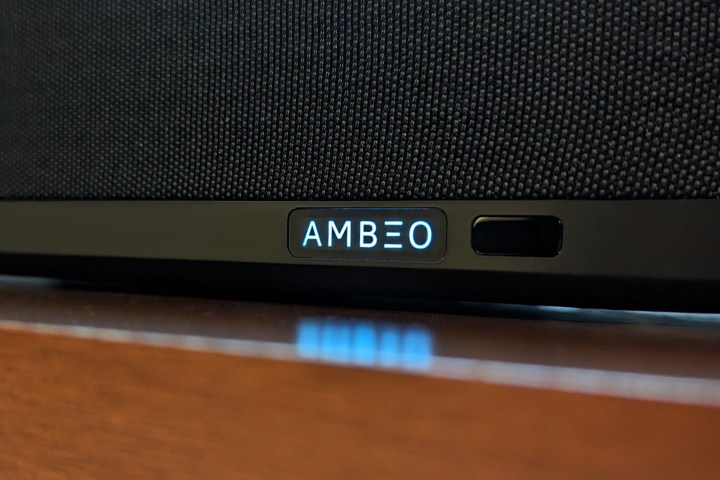
While no sound system can get around poorly recorded dialog or heavily compressed audio, the Ambeo Soundbar Mini is a fantastic add-on for those who struggle with their TV’s built-in speakers. Even before you turn on the optional voice enhancement mode, the speaker has excellent clarity.
That clarity extends beyond human voices, into the entire frequency spectrum, where it provides a level of detail and precision you won’t get from either the Bose Smart Soundbar 600 or the Sonos Beam Gen 2. This becomes especially noticeable when watching movies with Dolby Atmos soundtracks.
I had my doubts about the Ambeo Mini’s ability to provide immersive 3D sound since it lacks its more expensive siblings’ up-firing drivers, which are usually the key to getting realistic overhead sound effects from a single soundbar. But Sennheiser’s Ambeo virtualization, which it uses to place phantom speakers in a 7.1.4-channel configuration around your room, is remarkable. Using just four 1.6-inch full-range drivers (two front-firing and two side-firing) plus two four-inch woofers, this compact soundbar manages to sound far bigger and wider than its dimensions suggest.

My usual Atmos test clips from No Time To Die, Ford v. Ferrari, Mad Max: Fury Road, and Denis Villeneuve’s Dune, all came across with impressive energy and depth.
It’s so good, that after a few experiments listening with the Ambeo mode turned off, I left it on all of the time.
Just to be clear, the Ambeo Soundbar Mini doesn’t hold a candle to the Ambeo Soundbar Plus, or Sony’s HT-A7000, but it doesn’t have to. Those speakers offer even greater immersion and realism, with a size and a price to match. The Mini is meant for smaller spaces.
There is, however, one weakness in the Ambeo Soundbar Mini’s sonic chops: Its bass lacks oomph. Despite the presence of those two woofers, the Mini’s low-end sounds constrained. It’s not reasonable to expect a speaker of this size to pump out massive quantities of bass, but it’s not even a match for the Bose 600, which is actually a little smaller.
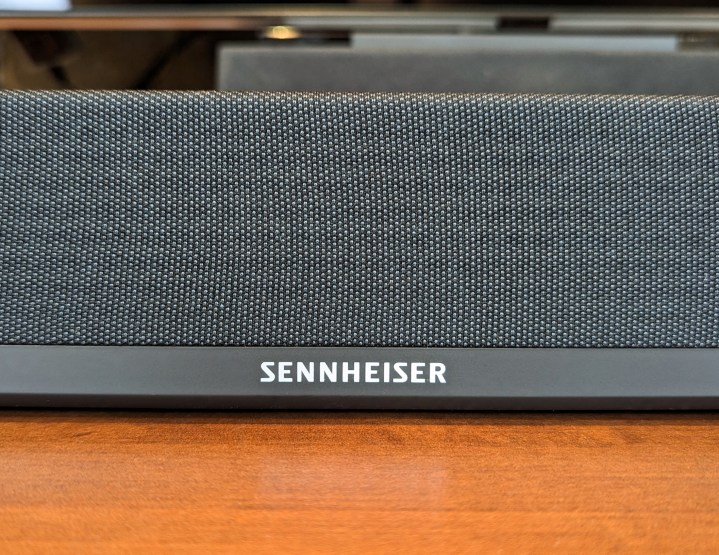
In fairness, the Mini’s bass is beautifully balanced and as with the rest of the sound signature, it’s got lots of detail. It just isn’t powerful enough to give movies the added visceral thrill that comes along with the thuds, booms, and rumbles that make so many of our favorite flicks worth watching.
That’s why I said earlier that you will want to add an Ambeo Sub. With a sub added to the mix, the Ambeo Soundbar Mini reaches its full potential: a performance that is both detailed and deep. But that combo drives the price to $1,500 — the same cost as the Ambeo Soudbar Plus. For $100 less, you can buy the Bose Smart Soundbar 600 plus a Bose wireless subwoofer and a set of wireless surround speakers.
And since comparisons to the Sony HT-A3000, Bose Smart Soundbar 600, and Sonos Beam Gen 2 are unavoidable, there’s one more gotcha you should know about. Unlike those other compact soundbars, you can’t expand the Ambeo Mini with wireless surround speakers — a limitation it shares with the Ambeo Max and Ambeo Plus.
Sennheiser Ambeo Soundbar Mini: music

The Mini’s Ambeo mode isn’t just for TV and movie content. The extra width and depth it creates, it does wonders for music too. Purists may argue that a traditional, two-channel presentation is the only way to listen to stereo recordings, but I suspect they’ll change their mind when listening on the Ambeo Soundbar Mini. With Ambeo mode, the soundbar’s virtualized speakers make up for the fact that a 27-inch speaker doesn’t actually create much stereo separation. It provides that missing width and does it without compromising the original material the way some 3D virtualizers can do.
Turn Ambeo mode off and the sound feels flat and a little lifeless. I’m sure a part of this is that the Ambeo Mini, with its two side-firing drivers, has been optimized for delivering Sennheiser’s surround sound wizardry. Turning Ambeo mode off is like tying one of its hands behind its back.
Ambeo mode even adds to the experience of listening to Dolby Atmos Music, which feels counterintuitive — why would you need to add additional spatial processing to a spatial sound format? Though the difference isn’t as pronounced as when listening to stereo tracks, Ambeo still adds yet more dimensionality to Atmos Music material.
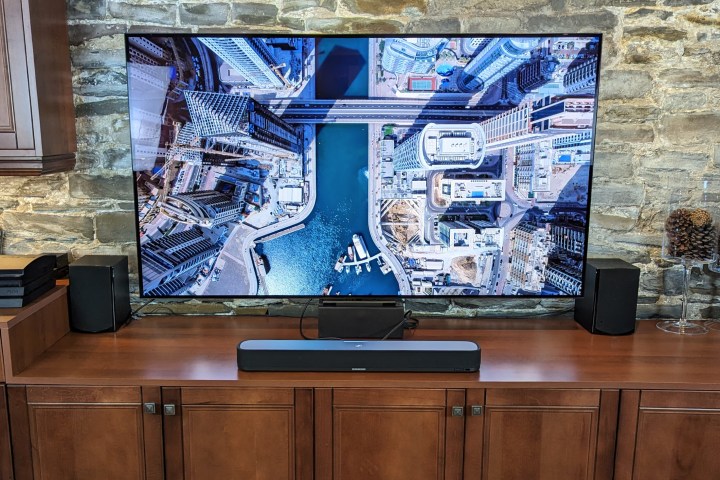
However, my observations of the soundbar in movie and TV mode are just as true when listening to music. Clarity and detail are impressive, especially in the mids, upper-mids, and high frequencies, but the Mini’s conservative approach to bass can rob a lot of tracks of their warmth and weight. I’m a fan of Hans Zimmer’s compositions, not only for their made-for-cinema emotional quality but also for their use of electronically created bass notes — which often extend into sub-bass territory, where they are felt as much as they are heard. Without the help of the Ambeo Sub, the Ambeo Soundbar Mini won’t render these elements the way they were meant to sound. Again, no speaker with the Mini’s dimensions can do what a subwoofer can do with bass, but Bose and Sonos both manage to do more with bass than Sennheiser.
With excellent wireless streaming support in the form of Bluetooth, Chromecast built-in, Apple AirPlay 2, Tidal Connect, and Spotify Connect, you’ll always be able to get the most out of your preferred streaming music service. Unfortunately, my review unit seemed to suffer from a strange bug that, as of the publication of this review, Sennheiser hadn’t fixed: some tracks — usually those with strong bass notes at the start, like Billie Eilish’s Bad Guy — created a random clicking sound within the first five-to-seven seconds of hitting play.
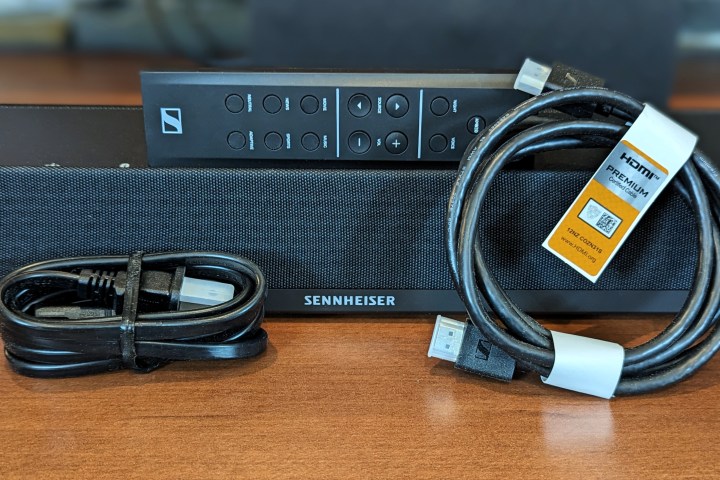
It only happened when beginning a streaming session — in other words, if Bad Guy was the second track in a playlist, it didn’t happen — and it always went away after that initial few seconds, but it was noticeable and kind of annoying. I trust that Sennheiser will find a permanent solution for this with a firmware update, but in the meantime, you’ve been warned.
Sennheiser’s Ambeo Soundbars cost a lot when compared to their peers. In the case of both the Ambeo Soundbar Max and the Ambeo Soundbar Plus, that premium is offset by the speakers’ incredible performance and features. With the Ambeo Soundbar Mini, I’m not as convinced that you’re going to feel the same way.
As impressive as its virtualization of multichannel and Dolby Atmos sound is, its underwhelming bass performance combined with its inability to expand into a full home theater system with additional wireless surround speakers keeps the $800 speaker from achieving a clear lead over its lower-priced competition from Sony, Sonos, and Bose.
Editors' Recommendations
- The ultimate guide to Dolby Atmos: what it is and how to get the best possible sound
- Bose’s new flagship Dolby Atmos soundbar brings AI smarts to the dialogue problem
- DTS Play-Fi wireless audio adds support for Dolby Atmos, DTS:X
- Nakamichi increases the price of its Dragon 11.4.6 soundbar
- How we test soundbars

